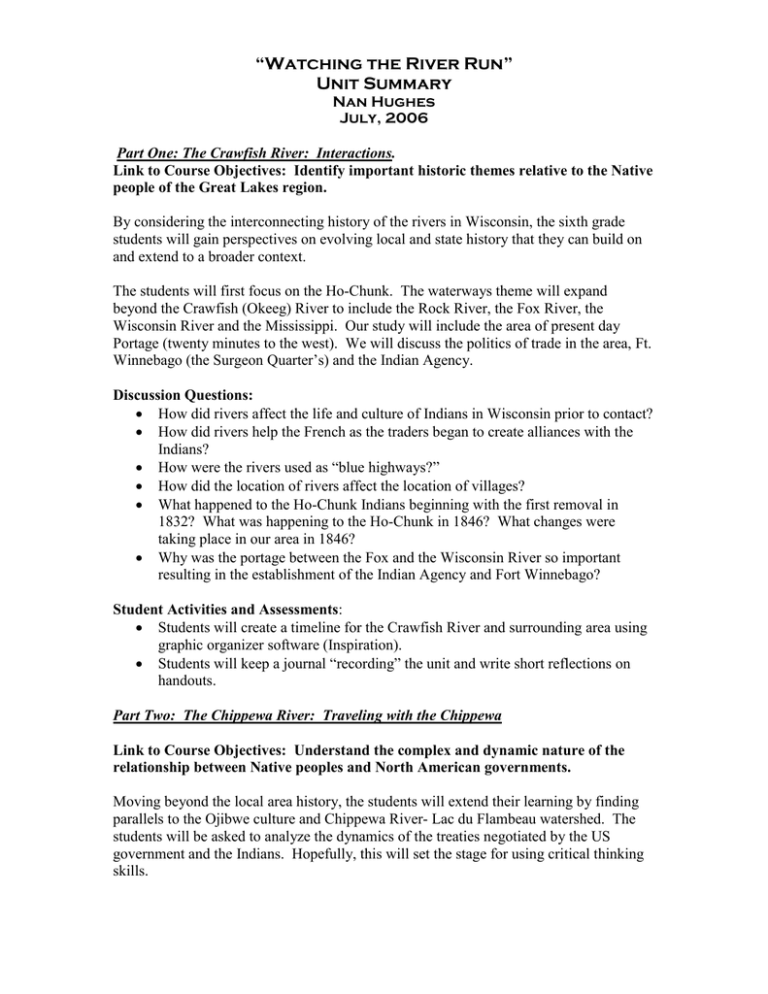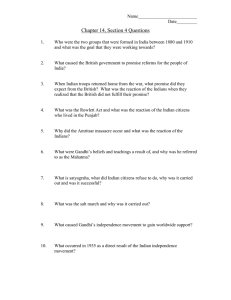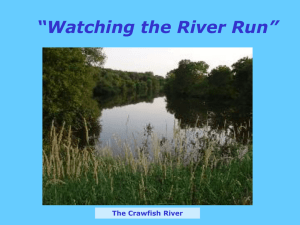“Watching the River Run” Unit Summary
advertisement

“Watching the River Run” Unit Summary Nan Hughes July, 2006 Part One: The Crawfish River: Interactions. Link to Course Objectives: Identify important historic themes relative to the Native people of the Great Lakes region. By considering the interconnecting history of the rivers in Wisconsin, the sixth grade students will gain perspectives on evolving local and state history that they can build on and extend to a broader context. The students will first focus on the Ho-Chunk. The waterways theme will expand beyond the Crawfish (Okeeg) River to include the Rock River, the Fox River, the Wisconsin River and the Mississippi. Our study will include the area of present day Portage (twenty minutes to the west). We will discuss the politics of trade in the area, Ft. Winnebago (the Surgeon Quarter’s) and the Indian Agency. Discussion Questions: How did rivers affect the life and culture of Indians in Wisconsin prior to contact? How did rivers help the French as the traders began to create alliances with the Indians? How were the rivers used as “blue highways?” How did the location of rivers affect the location of villages? What happened to the Ho-Chunk Indians beginning with the first removal in 1832? What was happening to the Ho-Chunk in 1846? What changes were taking place in our area in 1846? Why was the portage between the Fox and the Wisconsin River so important resulting in the establishment of the Indian Agency and Fort Winnebago? Student Activities and Assessments: Students will create a timeline for the Crawfish River and surrounding area using graphic organizer software (Inspiration). Students will keep a journal “recording” the unit and write short reflections on handouts. Part Two: The Chippewa River: Traveling with the Chippewa Link to Course Objectives: Understand the complex and dynamic nature of the relationship between Native peoples and North American governments. Moving beyond the local area history, the students will extend their learning by finding parallels to the Ojibwe culture and Chippewa River- Lac du Flambeau watershed. The students will be asked to analyze the dynamics of the treaties negotiated by the US government and the Indians. Hopefully, this will set the stage for using critical thinking skills. Discussion Questions: Why is fishing an important tribal activity today and how is it protected by treaties the tribes made with the federal government? How did people gather wild rice in the past? How does that activity fit in with people’s lives and customs today? How does it fit in with the tribe’s feelings about protecting natural resources? How does the pictograph presented by the Ojibwa chiefs clarify their feelings to those who have obstacles preventing them from understanding the Ojibwa viewpoint? Students Activities and Assessments: Students will create a poster illustrating the themes of this part of the lesson using four pictures (two of which must be of historical significance) and creating a paragraph for their poster that explains the content. Posters will be displayed in the LMC. Students will continue with their journals. Part Three: Rivers of Knowledge: Working Together for Consensus Link to Course Objectives: Interpret present-day events in relation to their historical antecedents. Think critically about the historic and contemporary American Indian experiences. Students will be asked to analyze the Indian Boarding School history, contemporary Indian cultural initiatives, the importance of language to a culture, the partnership that exists between people to protect natural resources, and the education efforts that are going on today to preserve cultural heritage. Discussion Questions: How does the situation of the students at the Lac du Flambeau Indian School during the 1920s show us the attitudes of non-Indians toward the children? How do people feel who have been forced to learn and speak a language that isn’t the language of their families? Why is it important for everyone to work together to preserve natural resources? What is the Great Lakes Indian Fish & Wildlife Commission doing today to protect the environment, fishing and hunting? How do the rivers of Wisconsin still “hold” us together? Student Activities and Assessments: Students will interpret maps and graphs relating to the topics. Students will chose between a role playing skit, readers’ theater presentation or presenting a six slide PowerPoint presentation comparing past to present as it relates to Indian Boarding Schools, the present day work of the Great Lake Indian Fish and Wildlife Commission, or the changing roles of rivers in Wisconsin.


